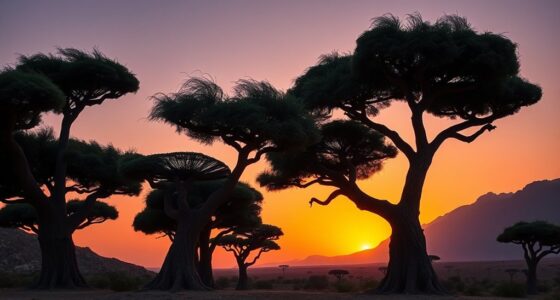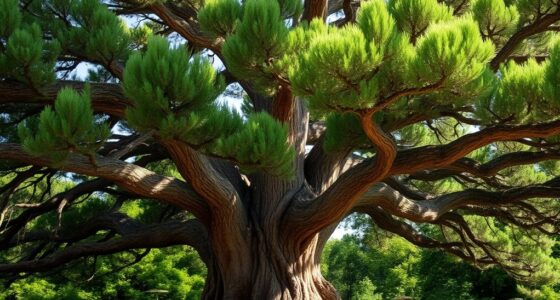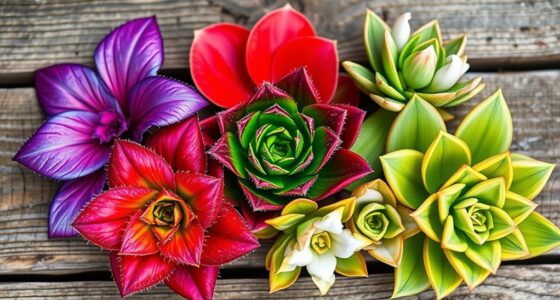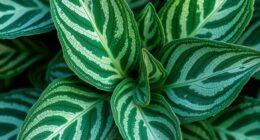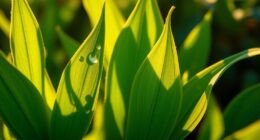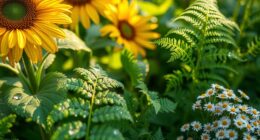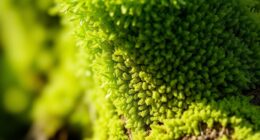The Florida yew is critically endangered, and its survival depends on efforts to combat habitat loss and illegal collection. Threatened by land development, climate change, and poaching, conservation groups are actively restoring habitats, protecting remaining plants, and raising public awareness. Your support can make a difference by participating in community efforts, advocating for stronger laws, or volunteering with organizations. To discover more about how you can help save this rare species, explore the ongoing conservation fight.
Key Takeaways
- The Florida yew is critically endangered due to habitat loss and illegal collection in southeastern U.S. forests.
- Conservation efforts include habitat restoration, protected areas, and cultivating plants for reintroduction.
- Enforcement of anti-poaching laws and public awareness campaigns are vital to prevent illegal harvesting.
- Community involvement and volunteering support the preservation and monitoring of remaining populations.
- Protecting the Florida yew helps maintain ecological balance and safeguard regional biodiversity.

Have you ever heard of the rare Florida yew? This elusive plant, native to the southeastern United States, especially Florida, is critically endangered and faces numerous threats to its survival. One of the biggest challenges is habitat loss. As development expands and land is cleared for construction or agriculture, the Florida yew’s natural habitat diminishes rapidly. To combat this, conservationists focus on habitat restoration efforts, working to restore and protect the remaining areas where these yews thrive. This involves removing invasive species, planting native vegetation, and ensuring the environment remains suitable for the yew’s growth. Restoring its habitat not only helps the Florida yew but also supports the entire ecosystem that depends on this unique plant. Additionally, climate change poses an emerging threat that could further threaten its delicate habitat and survival prospects.
Another serious issue threatening the Florida yew is illegal collection. Despite its protected status, some people still illegally harvest these plants for personal use or sale. This activity depletes the limited population and hinders natural regeneration. Illegal collection is particularly damaging because it often targets mature specimens, which are crucial for seed production and the plant’s long-term survival. When mature yews are removed from the wild, the genetic diversity of the species also suffers, making it harder for the population to adapt and recover. Conservation groups are actively working to enforce laws against illegal collection, but it remains a persistent problem. Public awareness campaigns aim to educate people about the importance of preserving native species and discourage illegal harvesting.
Efforts to conserve the Florida yew are multi-faceted. Besides habitat restoration, scientists are cultivating the plant in controlled environments to boost numbers and potentially reintroduce them into the wild. These cultivated plants help establish new populations and serve as a genetic reservoir. Additionally, protected areas are designated to prevent further habitat destruction and illegal collection. Local communities and volunteers play essential roles in monitoring and safeguarding the remaining populations. By fostering a sense of stewardship and emphasizing the plant’s importance, conservationists hope to rally more support for the Florida yew’s survival. Promoting public engagement and education about native plant conservation is also key to long-term success.
If you’re interested in helping, you can support organizations dedicated to habitat restoration and anti-poaching initiatives. Your involvement could include volunteering, spreading awareness, or advocating for stronger laws to combat illegal collection. Every effort counts in the fight to save the Florida yew from extinction. By understanding the threats it faces and supporting conservation initiatives, you contribute to preserving this rare species for future generations. Protecting the Florida yew isn’t just about saving a plant; it’s about maintaining the delicate balance of our natural ecosystems and ensuring that this rare piece of Florida’s botanical heritage endures.
Frequently Asked Questions
How Do Florida Yews Reproduce Naturally?
You might be surprised to learn that Florida yews reproduce naturally through seed dispersal. They produce small, cone-like structures during flowering cycles, which develop into seeds. When animals or birds encounter these seeds, they often carry and disperse them, helping new yews grow in the wild. This natural process guarantees the continuation of Florida yews, although their rarity makes this process even more essential to their survival.
Are There Any Ongoing Recovery Programs for Florida Yews?
Yes, there are ongoing recovery programs for Florida yews. You can support these efforts by contributing to conservation funding and botanical research initiatives focused on this rare species. These programs work to protect existing populations, restore habitats, and study the plant’s growth needs. By staying informed and involved, you help guarantee the Florida yew‘s survival for future generations. Your support makes a real difference in conservation efforts.
What Specific Threats Do Florida Yews Face From Climate Change?
You need to understand that climate impact and habitat loss threaten Florida yews directly. Rising temperatures and changing rainfall patterns can stress these plants, making them more vulnerable to disease. Additionally, habitat loss from development reduces their living space, further endangering their survival. By addressing these threats, conservation efforts can help protect and restore Florida yews, ensuring they don’t vanish due to climate change.
Can Private Landowners Participate in Florida Yew Conservation?
Yes, as a landowner, you can participate in Florida yew conservation through private land conservation efforts. Your involvement helps protect this rare species by maintaining its habitat and preventing development. You can work with local conservation groups or government programs to establish protected areas or implement sustainable practices. Landowner involvement is essential, as it directly supports the preservation of Florida yews and promotes biodiversity.
How Long Does It Take for a Florida Yew to Mature?
The growth timeline for a Florida yew varies, but you can expect it to reach maturity age in about 15 to 20 years. During this period, it grows slowly, developing its distinctive needle-like leaves and compact form. If you’re cultivating one, be patient, as it takes time to mature fully. Proper care and protection are essential for ensuring it reaches its full potential and contributes to conservation efforts.
Conclusion
You can make a real difference, like a steady hand guiding a fragile treasure. By supporting conservation efforts and spreading awareness, you help protect the Florida Yew, a rare gem hiding in plain sight. Just as a single drop can fill a bucket, your actions ripple outward, preserving this unique plant for generations. Together, we can turn the tide and guarantee the Florida Yew’s story continues, resilient and thriving like a quiet, steadfast guardian.



